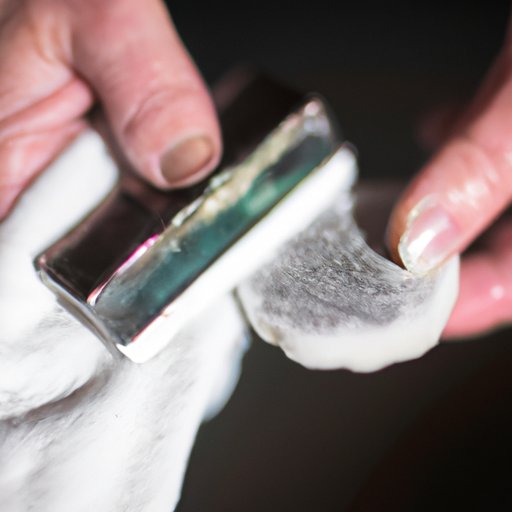Introduction
Do you have tarnished silver lying around your house that needs polishing? If so, you’re not alone. Tarnished silver is a common problem that affects anyone who owns silverware or jewelry. The good news is that it’s easy to clean and restore your silver’s shine with a few simple tips and tricks. In this article, we will explore the different methods for cleaning your tarnished silver, from old-school techniques to modern cleaning methods. We’ll also discuss how to properly store your silver to prevent tarnishing. Let’s get started!
The Chemistry Behind Tarnished Silver: A Guide to Cleaning Your Precious Items
Silver tarnishes over time due to oxidation, which results in a dark, dull layer on the surface of your silver. This layer, called silver sulfide, is a natural reaction caused by exposure to air, moisture, and other elements. Over time, silver can also become tarnished due to exposure to substances like salt, sulfur, and acids.
There are different types of silver, and each one reacts differently to tarnish. Sterling silver, for example, is made up of 92.5% silver and 7.5% other metals like copper. It is more susceptible to tarnish than other types of silver, such as fine silver or coin silver.
Thankfully, there are many effective cleaning tips that can be used to clean tarnished silver using simple household items. For example, baking soda and toothpaste, when mixed with water, create a paste that can be used to remove tarnish from silver. Simply apply the paste to your silver with a soft cloth or sponge, then rinse it clean and dry it with a soft cloth.
Old-School vs New-Age Cleaning Techniques for Your Silver
There are traditional methods of cleaning silver, including polishing cloths and silver dips. Polishing cloths can be used to remove light tarnish and buff your silver to a shine. Silver dips are a more aggressive cleaning method that involves soaking your silver in a solution that removes tarnish. However, silver dips can be harmful to your silver if not used properly, and can even remove some of the silver’s surface.
Modern techniques for cleaning silver include ultrasonic cleaners and steam cleaning machines. Ultrasonic cleaners use high-frequency sound waves to clean your silver and are particularly useful for cleaning items with intricate designs or hard-to-reach crevices. Steam cleaning machines use high heat and pressure to remove tarnish and can be used for larger items like silver trays and teapots.
Both traditional and modern techniques have their pros and cons. Traditional methods are generally safer and more affordable, while modern cleaning techniques are more efficient and offer more thorough cleaning. However, we recommend using modern cleaning techniques sparingly, and always following the manufacturer’s instructions carefully, to avoid any damage to your silver.
Out Of The Box: Creative Ways to Clean Your Silverware and Jewelry
If you’re looking for alternative cleaning methods, there are several safe and effective options. For example, vinegar and lemon juice can be used to remove tarnish from your silver. Simply mix equal parts water and vinegar or lemon juice, then soak your silver in the mixture for a few minutes. Ketchup is another surprising alternative cleaning method- just rub it onto your silver and let it sit for a few minutes, then rinse it off and wipe it with a cloth.
If you want to get creative, try using baking soda and aluminum foil to clean your silver. Line a bowl with aluminum foil, then fill it with hot water and a tablespoon of baking soda. Place your tarnished silver in the bowl, making sure it touches the foil, and let it soak for a few minutes. The combination of baking soda and aluminum foil will create a chemical reaction that removes tarnish from your silver.
Keep Your Silver Safe: How to Store and Clean It
Proper storage of silver is key to preventing tarnish. Your silver should be stored in a cool, dry place away from direct sunlight. If possible, store your silver in airtight containers or bags to prevent exposure to air and moisture.
To clean silverware and jewelry, use a soft cloth or sponge and a mild detergent like dish soap. Avoid using abrasive materials like steel wool or harsh chemical cleaners, as these can damage your silver. If you’re unsure about how to clean a specific piece of silver, it’s always best to seek the advice of a professional.
Remember to always handle your silver carefully, using gloves or a soft cloth, to avoid smudging or scratching the surface. And finally, it’s important to clean your silver regularly to prevent tarnishing and maintain its beauty and value.
From Antique Silver to Everyday Items: How to Clean Them All
If you have antique silver, it’s important to be extra careful when cleaning it. Antique silver can be easily damaged, scratched or discolored if cleaned improperly. We recommend using silver polish and a soft cloth to clean antique silver. Be sure to follow the instructions on the silver polish, and always rinse and dry the silver carefully after cleaning.
For everyday silverware and jewelry, cleaning and maintenance is key. Regularly washing and drying your silver will prevent tarnishing and keep it looking its best. If you notice any darkening or discoloration of your silver, it may be time for a deeper clean using one of the methods we’ve discussed in this article.
Conclusion
Whether you have antique silver or everyday silverware, keeping your silver clean and shiny is easy with the right methods and tools. From traditional polishing cloths to modern ultrasonic cleaners, there are many ways to remove tarnish from your silver and restore its beauty. Remember to always handle your silver with care, and store it properly to prevent tarnishing. With the tips and tricks we’ve discussed in this article, you can keep your silver looking its best for years to come.
